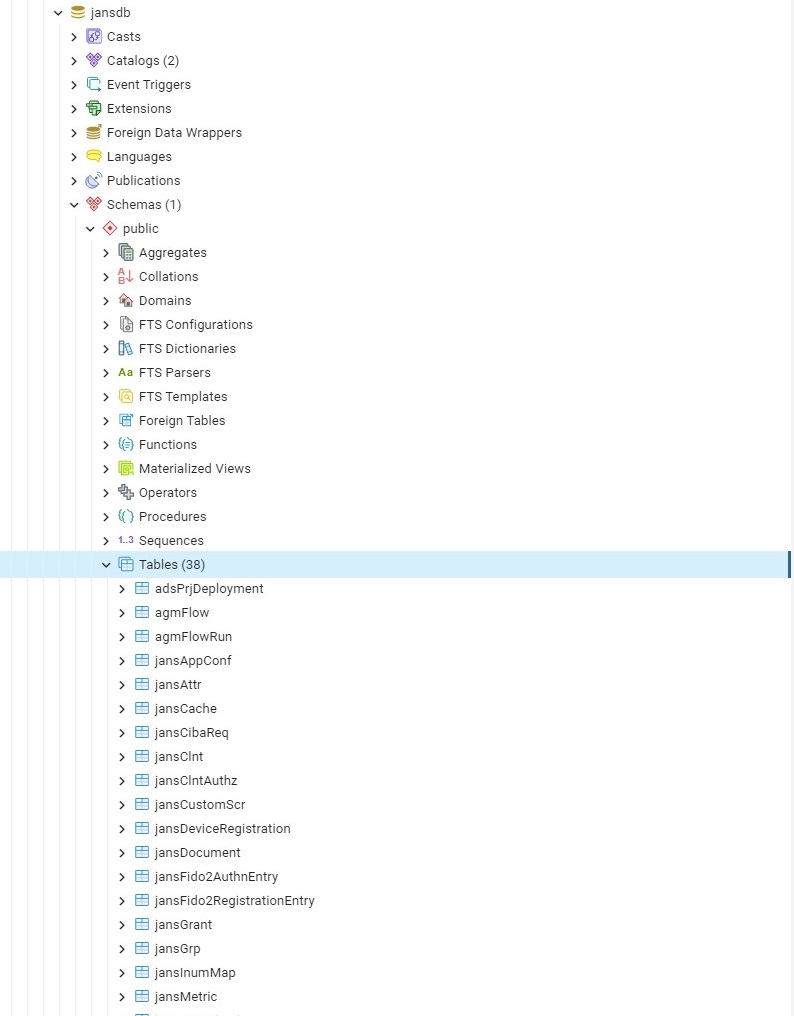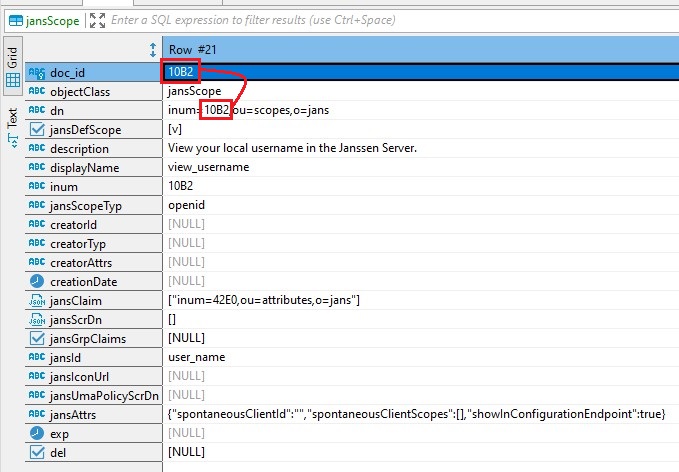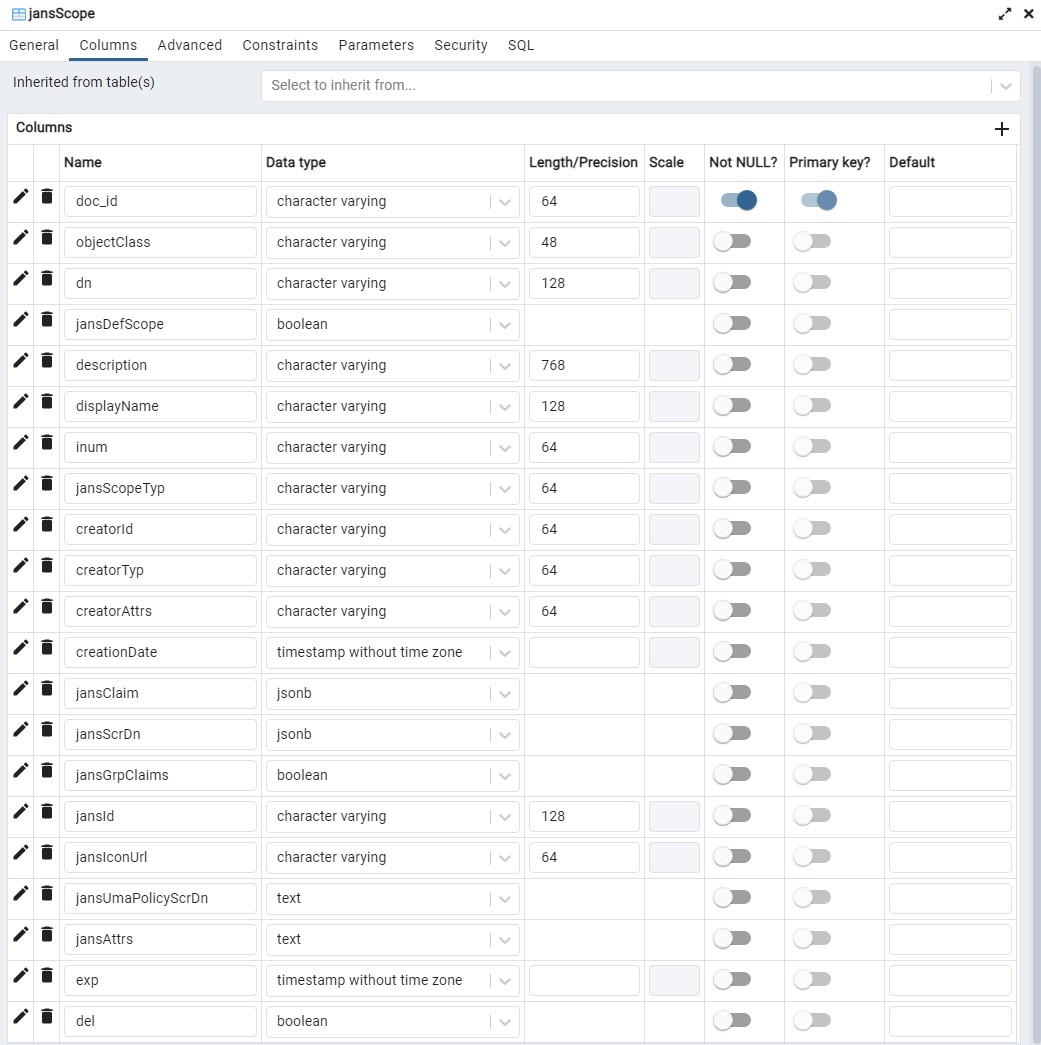PostgreSQL ORM persistence layer#
The recommended PostgreSQL versions are 14.x, 15.x or newer. Before running installation the administrator can pre-install DB and provide credentials to access it or he can select option to install PostgreSQL on same server during setup.
During installation setup generates default /etc/jans/conf/jans-sql.properties and creates jansdb schema with tables and initial data set.

Configuration properties#
List of specific for PostgreSQL default setting from jans-sql.properties:
db.schema.name=public
connection.uri=jdbc:postgresql://localhost:5432/jansdb
# Prefix connection.driver-property.key=value will be coverterd to key=value JDBC driver properties
#connection.driver-property.driverProperty=driverPropertyValue
auth.userName=jans
auth.userPassword=CC0NHhtXW78=
# Password hash method
password.encryption.method=SSHA-256
# Connection pool size
connection.pool.max-total=40
connection.pool.max-idle=15
connection.pool.min-idle=5
# Max time needed to create connection pool in milliseconds
connection.pool.create-max-wait-time-millis=20000
# Max wait 20 seconds
connection.pool.max-wait-time-millis=20000
# Allow to evict connection in pool after 30 minutes
connection.pool.min-evictable-idle-time-millis=1800000
# Sets whether objects created for the pool will be validated before being returned from it
#connection.pool.test-on-create=true
# Sets whether objects borrowed from the pool will be validated when they are returned to the pool
#connection.pool.test-on-return=true
The rest of properties are static for all other supported DB:
binaryAttributes=objectGUID
certificateAttributes=userCertificate
doc_id building rules#
In order to support transparency for end applications and allow data migration from one DB to another ORM requires DN attribute in each entry. This attribute it also uses to build doc_id. Here is example of this DN -> doc_id conversion:

doc_id is primary key. In order to build unique document identifier ORM uses another unique attribute DN. doc_id is last RDN value.
Generic tables structure#
Each table in jansdb PostgreSQL database follow next rules:
- one table for every LDAP objectClass
- has 2 mandatory column
DNanddoc_id - Index for primary key

Data mapping rules#
ORM uses CHARACTER VARYING / TIMESTAMP / INT64 / BYTEA / BOOLEAN / TEXT / JSONB data types.

JSONB it uses to store multi-valued attribute values. The generic format of such values is:
["value_1", "value_2", ...]
CREATE INDEX IF NOT EXISTS "jansPerson_jsonb_path_query_array_idx"
ON public."jansPerson" USING gin
(jsonb_path_query_array("jansExtUid", '$[*]'::jsonpath))
TABLESPACE pg_default;
For user password field ORM on persist/update operations automatically create hash. On authentication ORM compares hashes.

To store attributes defined in java beans with @JsonObject annotation ORM uses TEXT column type.

Java example#
This example shows how to use ORM. It opens connection to PostgreSQL DB and add user entry to it:
public static void main(String[] args) {
// Create Sql entry manager
SqlEntryManager couchbaseEntryManager = createSqlEntryManager();
// Create and fill user bean
SimpleUser newUser = new SimpleUser();
newUser.setDn(String.format("inum=%s,ou=people,o=jans", System.currentTimeMillis()));
newUser.setUserId("sample_user_" + System.currentTimeMillis());
newUser.setUserPassword("test");
newUser.getCustomAttributes().add(new CustomObjectAttribute("jansAddres", Arrays.asList("London", "Texas", "New York")));
newUser.getCustomAttributes().add(new CustomObjectAttribute("jansGuid", "test_value"));
// Call ORM API to store entry
couchbaseEntryManager.persist(newUser);
couchbaseEntryManager.destroy();
}
public static SqlEntryManager createSqlEntryManager() {
SqlEntryManagerFactory couchbaseEntryManagerFactory = new SqlEntryManagerFactory();
couchbaseEntryManagerFactory.create();
Properties connectionProperties = getSampleConnectionProperties();
SqlEntryManager couchbaseEntryManager = couchbaseEntryManagerFactory.createEntryManager(connectionProperties);
return couchbaseEntryManager;
}
private static Properties getSampleConnectionProperties() {
Properties connectionProperties = new Properties();
connectionProperties.put("sql#db.schema.name", "public");
connectionProperties.put("sql#connection.uri", "jdbc:postgresql://localhost:5432/jansdb");
connectionProperties.put("sql#auth.userName", "jans");
connectionProperties.put("sql#auth.userPassword", "secret");
connectionProperties.put("sql#connection.pool.max-total", "300");
connectionProperties.put("sql#connection.pool.max-idle", "300");
connectionProperties.put("sql#auth.userName", "jans");
connectionProperties.put("sql#auth.userPassword", "Secret1!");
// Password hash method
connectionProperties.put("sql#password.encryption.method", "SSHA-256");
// Max time needed to create connection pool in milliseconds
connectionProperties.put("sql#connection.pool.create-max-wait-time-millis", "20000");
// Max wait 20 seconds
connectionProperties.put("sql#connection.pool.max-wait-time-millis", "20000");
// Allow to evict connection in pool after 30 minutes
connectionProperties.put("sql#connection.pool.min-evictable-idle-time-millis", "1800000");
connectionProperties.put("sql#binaryAttributes", "objectGUID");
connectionProperties.put("sql#certificateAttributes", "userCertificate");
return connectionProperties;
}
More MySQL ORM examples is in this sample module.
Created: 2022-07-21